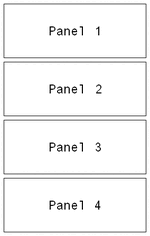Tag: sourceedit |
|||
| (2 intermediate revisions by the same user not shown) | |||
| Line 3: | Line 3: | ||
==Origin== |
==Origin== |
||
| − | [[Rakuten Kitazawa]] (who wrote under the name Yasuji Kitazawa) produced the first yonkoma in 1902. Entitled "[[Jiji Manga]]", it was thought to have been influenced by the works of [[Frank Arthur Nankivell]] and of [[Frederick Burr Opper]].<ref>Carolin Fischer,'Mangaka'',Unknown date of publication, "http://www.mangaka.co.uk/?page=yonkoma", 2009-10-29</ref> [[Jiji Manga]] appeared in the Sunday edition. |
+ | [[Rakuten Kitazawa]] (who wrote under the name Yasuji Kitazawa) produced the first yonkoma in 1902. Entitled "[[Jiji Manga]]", it was thought to have been influenced by the works of [[Frank Arthur Nankivell]] and of [[Frederick Burr Opper]].<ref>Carolin Fischer,'Mangaka'',Unknown date of publication, "http://www.mangaka.co.uk/?page=yonkoma", 2009-10-29</ref> [[Jiji Manga]] appeared in the Sunday edition. |
==Structure== |
==Structure== |
||
| Line 13: | Line 13: | ||
==Uses== |
==Uses== |
||
| − | These comic strips appear in almost all types of publications in Japan, including [[manga]] magazines, [[graphic novel]]s, the comics section of Newspapers, game magazines, cooking magazines, and so forth. The plot often ends within the four panels, although some |
+ | These comic strips appear in almost all types of publications in Japan, including [[manga]] magazines, [[graphic novel]]s, the comics section of Newspapers, game magazines, cooking magazines, and so forth. The plot often ends within the four panels, although some Serial development may pass on to future installments, creating a more continuous story. Some yonkoma also tackle serious topics, though most do so with humor. Some manga occasionally use yonkoma, usually at the end of a chapter or bound volume, as a non-canon joke to complement the story. |
==Internet Popularity== |
==Internet Popularity== |
||
| − | {{Unreliable sources |section|date=March 2011}} |
||
Yonkoma eventually found a place with the [[online communities]] after Gaijin 4Koma (also known as Reaction Guys, a title originating from [[4chan]]) caught the attention of the notorious [[Futaba Channel]]. Yonkoma have since been adapted to many Internet [[memes]], and the original The Reaction Guys image has inspired countless [[parody|spoof]]s as well. |
Yonkoma eventually found a place with the [[online communities]] after Gaijin 4Koma (also known as Reaction Guys, a title originating from [[4chan]]) caught the attention of the notorious [[Futaba Channel]]. Yonkoma have since been adapted to many Internet [[memes]], and the original The Reaction Guys image has inspired countless [[parody|spoof]]s as well. |
||
Latest revision as of 12:20, 24 May 2015

Traditional Yonkoma layout
Yonkoma manga (4コマ漫画, "four cell manga", or 4-koma for short), a comic-strip format, generally consists of gag comic strips within four panels of equal size ordered from top to bottom. (They also sometimes run right-to-left horizontally or use a hybrid 2x2 style, depending on the layout requirements of the publication in which they appear.) Though the word yonkoma comes from the Japanese, the style also exists outside of Japan in other Asian countries as well as in the English-speaking market.
Origin
Rakuten Kitazawa (who wrote under the name Yasuji Kitazawa) produced the first yonkoma in 1902. Entitled "Jiji Manga", it was thought to have been influenced by the works of Frank Arthur Nankivell and of Frederick Burr Opper.[1] Jiji Manga appeared in the Sunday edition.
Structure
Traditionally, Yonkoma follow a structure known as Kishōtenketsu. This word is a compound formed from the following Japanese Kanji characters:
- Ki: The first panel forms the basis of the story; it sets the scene.
- Shō: The second panel develops upon the foundation of the story laid down in the first panel.
- Ten: The third panel is the climax, in which an unforeseen development occurs.
- Ketsu: The fourth panel is the conclusion, in which the effects of the third panel are seen.[2]
Uses
These comic strips appear in almost all types of publications in Japan, including manga magazines, graphic novels, the comics section of Newspapers, game magazines, cooking magazines, and so forth. The plot often ends within the four panels, although some Serial development may pass on to future installments, creating a more continuous story. Some yonkoma also tackle serious topics, though most do so with humor. Some manga occasionally use yonkoma, usually at the end of a chapter or bound volume, as a non-canon joke to complement the story.
Internet Popularity
Yonkoma eventually found a place with the online communities after Gaijin 4Koma (also known as Reaction Guys, a title originating from 4chan) caught the attention of the notorious Futaba Channel. Yonkoma have since been adapted to many Internet memes, and the original The Reaction Guys image has inspired countless spoofs as well.
Examples of yonkoma manga
Well-known manga drawn using the yonkoma style include:
- .hack//4 Koma
- Acchi Kocchi
- Azumanga Daioh
- B Gata H Kei
- Baito-kun
- Choir!
- Hetalia: Axis Powers
- Hidamari Sketch
- K-On!
- Kanamemo
- Kill Me Baby
- Kobo, the Li'l Rascal
- Lucky Star
- Neko Rahmen
- Nono-chan
- Nyorōn Churuya-san
- Puchimas! Petit Idolmaster
- Sazae-san
- Seitokai Yakuindomo
- Sketchbook
- Taberemasen
See also
- Kishōtenketsu - A writing technique specific to 4-panel comics
- Jo-ha-kyū - A type of three-act structure found in many traditional Japanese narrative forms
References
- ↑ Carolin Fischer,'Mangaka,Unknown date of publication, "http://www.mangaka.co.uk/?page=yonkoma", 2009-10-29
- ↑ Carolin Fischer,'Mangaka,Unknown date of publication, "http://www.mangaka.co.uk/?page=yonkoma", 2009-10-29
| |||||||||||||||||||||||||

